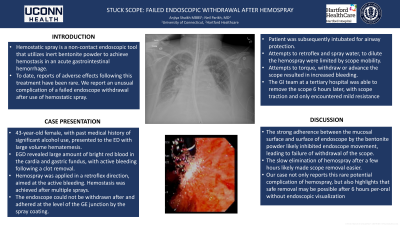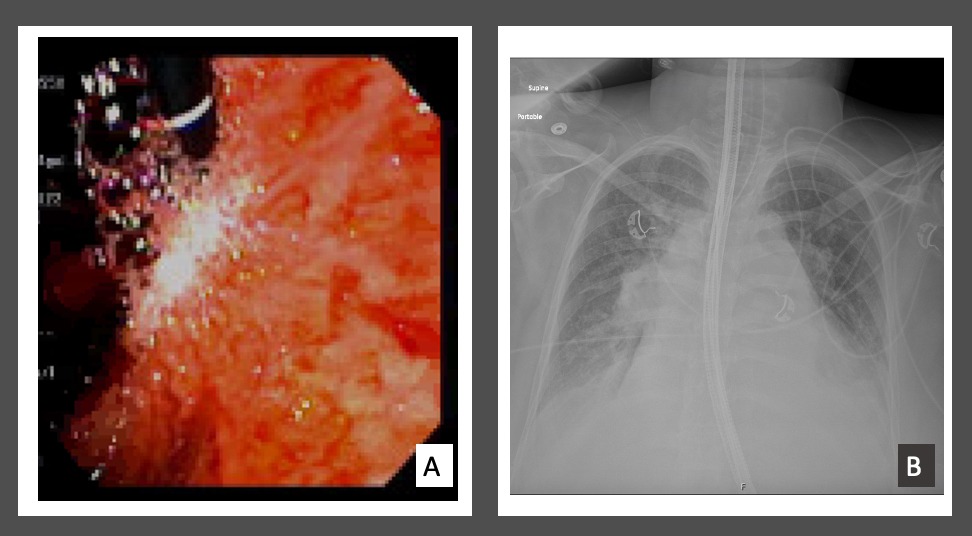Back

Poster Session D - Tuesday Morning
Category: General Endoscopy
D0295 - Stuck Scope: Failed Endoscopic Withdrawal After Hemospray
Tuesday, October 25, 2022
10:00 AM – 12:00 PM ET
Location: Crown Ballroom

- AS
Anjiya Shaikh, MBBS
University of Connecticut
Hartford, CT, CT
Presenting Author(s)
Anjiya Shaikh, MBBS1, Neil D. Parikh, MD2
1University of Connecticut, Hartford, CT; 2Hartford Healthcare, Hartford, CT
Introduction: Hemostatic spray is a non-contact endoscopic tool that utilizes inert bentonite powder to achieve hemostasis in an acute gastrointestinal hemorrhage. To date, reports of adverse effects following this treatment have been rare. We report an unusual complication of a failed endoscope withdrawal after use of hemostatic spray.
Case Description/Methods: A 43-year-old female, with past medical history of significant alcohol use, presented to an outside ED with large volume hematemesis. She was started on a proton pump inhibitor and octreotide infusion and admitted to the ICU for a suspected upper GI bleed. She underwent an EGD, which showed large amount of bright red blood in the cardia and gastric fundus, alongside a large clot. Active bleeding followed clot removal attempt. The hemospray was applied in a retroflex direction, aimed at the blushing beneath the clot in the fundus. After multiple sprays, hemostasis was achieved. However, the endoscope could not be withdrawn after and adhered at the level of the GE junction by the spray coating. Patient was subsequently intubated for airway protection. Attempts to retroflex and spray water, to dilute the hemospray were limited by scope mobility. Attempts to torque, withdraw or advance the scope resulted in increased bleeding. An attempt to insert another scope alongside the previous one was made, however there was limited space. Due to risk of esophageal perforation with repeat attempt of endoscope removal, patient was transferred to a tertiary care hospital. The GI team was able to remove the scope with scope traction and only encountered mild resistance– 6 hours after the sentinel EGD. Endoscopy was repeated in 48 hours to find source of initial bleeding, however only portal hypertensive gastropathy was encountered with no active bleeding.
Discussion: Only one such case of a retained endoscope after hemospray use has been reported, where the scope was safely removed under direct endoscopic visualization after 48 hours –the time given to allow for complete elimination of powder from upper GI tract. In our case, the strong adherence between the mucosal surface and surface of endoscope by the bentonite powder likely inhibited endoscope movement, leading to failure of withdrawal of the scope. The slow elimination of hemospray after a few hours likely made scope removal easier. Our case not only reports this rare potential complication of hemospray, but also highlights that safe removal may be possible after 6 hours per-oral without endoscopic visualization

Disclosures:
Anjiya Shaikh, MBBS1, Neil D. Parikh, MD2. D0295 - Stuck Scope: Failed Endoscopic Withdrawal After Hemospray, ACG 2022 Annual Scientific Meeting Abstracts. Charlotte, NC: American College of Gastroenterology.
1University of Connecticut, Hartford, CT; 2Hartford Healthcare, Hartford, CT
Introduction: Hemostatic spray is a non-contact endoscopic tool that utilizes inert bentonite powder to achieve hemostasis in an acute gastrointestinal hemorrhage. To date, reports of adverse effects following this treatment have been rare. We report an unusual complication of a failed endoscope withdrawal after use of hemostatic spray.
Case Description/Methods: A 43-year-old female, with past medical history of significant alcohol use, presented to an outside ED with large volume hematemesis. She was started on a proton pump inhibitor and octreotide infusion and admitted to the ICU for a suspected upper GI bleed. She underwent an EGD, which showed large amount of bright red blood in the cardia and gastric fundus, alongside a large clot. Active bleeding followed clot removal attempt. The hemospray was applied in a retroflex direction, aimed at the blushing beneath the clot in the fundus. After multiple sprays, hemostasis was achieved. However, the endoscope could not be withdrawn after and adhered at the level of the GE junction by the spray coating. Patient was subsequently intubated for airway protection. Attempts to retroflex and spray water, to dilute the hemospray were limited by scope mobility. Attempts to torque, withdraw or advance the scope resulted in increased bleeding. An attempt to insert another scope alongside the previous one was made, however there was limited space. Due to risk of esophageal perforation with repeat attempt of endoscope removal, patient was transferred to a tertiary care hospital. The GI team was able to remove the scope with scope traction and only encountered mild resistance– 6 hours after the sentinel EGD. Endoscopy was repeated in 48 hours to find source of initial bleeding, however only portal hypertensive gastropathy was encountered with no active bleeding.
Discussion: Only one such case of a retained endoscope after hemospray use has been reported, where the scope was safely removed under direct endoscopic visualization after 48 hours –the time given to allow for complete elimination of powder from upper GI tract. In our case, the strong adherence between the mucosal surface and surface of endoscope by the bentonite powder likely inhibited endoscope movement, leading to failure of withdrawal of the scope. The slow elimination of hemospray after a few hours likely made scope removal easier. Our case not only reports this rare potential complication of hemospray, but also highlights that safe removal may be possible after 6 hours per-oral without endoscopic visualization

Figure: A - Endoscope position at gastric fundus
B - Chest X-ray post-intubation, showing retained scope
B - Chest X-ray post-intubation, showing retained scope
Disclosures:
Anjiya Shaikh indicated no relevant financial relationships.
Neil Parikh indicated no relevant financial relationships.
Anjiya Shaikh, MBBS1, Neil D. Parikh, MD2. D0295 - Stuck Scope: Failed Endoscopic Withdrawal After Hemospray, ACG 2022 Annual Scientific Meeting Abstracts. Charlotte, NC: American College of Gastroenterology.
